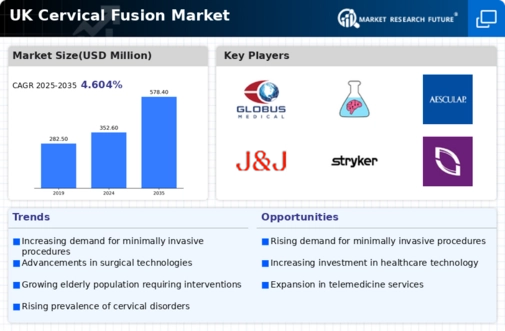Increased Healthcare Expenditure
The cervical fusion market is benefiting from the rising healthcare expenditure in the UK. With the government and private sectors investing more in healthcare services, there is a greater focus on improving surgical facilities and patient care. This increase in funding allows for the procurement of advanced medical technologies and training for healthcare professionals, which can enhance the quality of cervical fusion procedures. Reports indicate that healthcare spending in the UK has seen a steady rise, with projections suggesting an increase of approximately 5% annually over the next few years. This financial commitment is likely to facilitate better access to cervical fusion surgeries, ultimately expanding the market as more patients receive timely and effective treatment for their spinal conditions.
Advancements in Surgical Techniques
Innovations in surgical techniques are playing a crucial role in the cervical fusion market. The introduction of robotic-assisted surgeries and enhanced imaging technologies has improved the precision and outcomes of cervical fusion procedures. These advancements not only reduce the risk of complications but also shorten recovery times for patients. For instance, minimally invasive techniques have gained traction, allowing for smaller incisions and less tissue damage, which can lead to quicker rehabilitation. As a result, the adoption of these advanced surgical methods is likely to increase, driving the demand for cervical fusion procedures. Furthermore, the ongoing research and development in surgical instruments and techniques suggest a promising future for the cervical fusion market, as healthcare professionals continue to seek ways to enhance patient care and surgical efficacy.
Rising Incidence of Spinal Disorders
The cervical fusion market is experiencing growth due to the increasing prevalence of spinal disorders in the UK. Conditions such as cervical spondylosis and herniated discs are becoming more common, leading to a higher demand for surgical interventions. According to recent data, spinal disorders account for a significant portion of musculoskeletal issues, with estimates suggesting that around 30% of the adult population may experience some form of cervical spine problem during their lifetime. This trend is likely to drive the need for cervical fusion procedures, as patients seek effective solutions to alleviate pain and restore mobility. The growing awareness of treatment options and the effectiveness of cervical fusion surgeries further contribute to the expansion of the market, as healthcare providers increasingly recommend these procedures to manage chronic spinal conditions.
Growing Awareness of Treatment Options
There is a notable increase in awareness regarding treatment options for spinal disorders, which is positively impacting the cervical fusion market. Educational campaigns and patient advocacy groups are playing a vital role in informing the public about the benefits of cervical fusion surgeries. As patients become more knowledgeable about their conditions and available treatments, they are more likely to seek surgical interventions. This shift in patient behavior is expected to drive demand for cervical fusion procedures, as individuals look for effective solutions to manage chronic pain and improve their quality of life. Additionally, healthcare providers are increasingly discussing surgical options with patients, further contributing to the growth of the cervical fusion market as more individuals opt for these procedures.
Regulatory Support for Innovative Solutions
The cervical fusion market is also influenced by regulatory support for innovative medical solutions. The UK regulatory bodies are actively promoting the development and approval of new surgical techniques and devices that enhance patient outcomes. This supportive environment encourages manufacturers to invest in research and development, leading to the introduction of novel cervical fusion products. The approval of advanced biomaterials and implants, which can improve fusion rates and reduce complications, is likely to stimulate market growth. Furthermore, the collaboration between regulatory agencies and industry stakeholders suggests a commitment to advancing cervical fusion technologies, which may result in a wider array of treatment options for patients in the UK.





















Leave a Comment